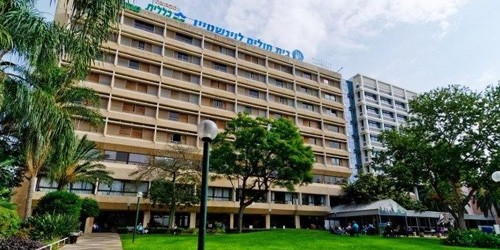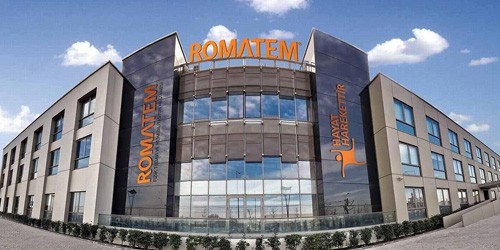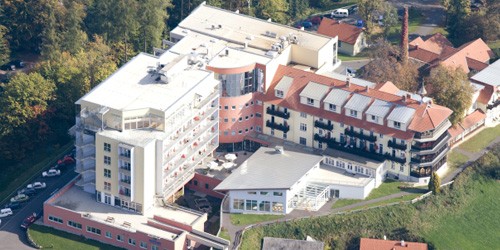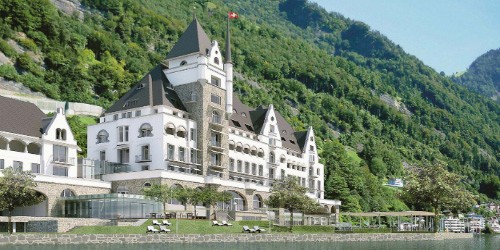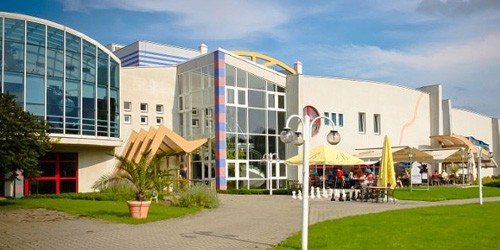The main cause of spinal fractures is injuries and accidents, but they can also occur due to metastatic tumours, multiple sclerosis, myelopathy and other conditions.
For every million people, 40-80 people need rehabilitation after a spinal injury yearly. It is a long and intensive process that involves a whole team of medical specialists.
Overseas clinics offer the most modern rehabilitation programmes for spinal injuries. They incorporate the latest advances in neurobiology and rehabilitation, as well as the use of robotic technology. You can read more about rehabilitation abroad in our article.
Listen to the article:
The prognosis for spinal cord injuries
The main factor that affects the recovery from a spinal cord injury is the severity of the trauma. Different countries use different measurement systems, e.g. ASIA, SCIM, WISCI II and others. It is usually possible to make a prognosis as early as the first 72 hours after injury.
Recovery is also affected by which part of the spine has been injured. The higher the fracture, the more the spinal cord may be affected. Patients with a cervical vertebrae injury will need the most extensive rehabilitation and their prognosis is less optimistic than for others.
It also matters whether the spinal cord injury is complete or incomplete. Complete injuries result in compression or rupture of the spinal cord, which greatly reduces the chances of recovery. Incomplete spinal cord injuries offer better prospects of recovery, especially as the swelling goes down and the spinal cord becomes less compressed.
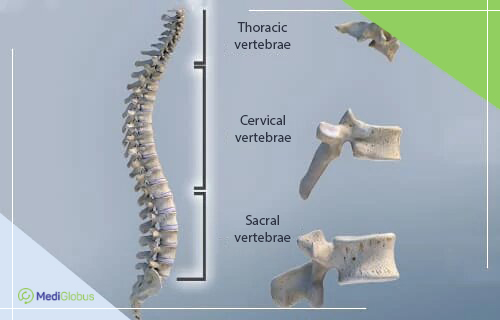
Patients with a spinal cord injury whose lesions are limited to the lower regions and who retain at least ⅗ of muscle strength have a good chance of being able to walk one year later. In most people who have suffered a spinal injury, recovery of nerve function occurs within the first 6 months after injury, although the health of some nerves can be restored after 5 years.
One of the underestimated stages of treatment after a spinal cord injury is psychological rehabilitation. Up to a third of patients show symptoms of depression, which negatively affects their well-being and motivation and can make rehabilitation difficult. Modern centres pay special attention to this aspect and the treatment course necessarily includes work with a psychologist and in therapy groups. The most effective methods of help for such patients are occupational therapy, which helps to regain independence in their daily activities and to find their place in society.
The acute rehabilitation period occurs in the first hours after the spinal injury and can last up to 12 weeks. During this phase, it is important to restore the patient’s strength and stability, which will help with subsequent treatment. Passive exercises and physiotherapy in bed are most often used. They prevent the formation of bedsores and cramps.
Afterwards comes the chronic rehabilitation phase. It aims to help the patient better integrate into society. Treatment includes work with physiotherapists, psychologists and occupational therapists. Factors such as injury level, age, weight, general health, motivation and spasticity affect the potential for recovery from a spinal cord injury. In general, patients with T10 vertebral injuries and above require inpatient treatment. Patients with T11-L2 injuries do not need hospitalisation for treatment in the chronic phase and can continue rehabilitation at home.
Techniques for rehabilitation after a spinal cord injury
A standard rehabilitation programme after a spinal cord injury usually includes the following elements:
Mobility training | The main exercises for spinal cord injuries are aimed at improving mobility by stretching tense muscles, moving joints and strengthening weakened muscles. Consistent repetition of movements helps stimulate the spinal cord and promotes neurological adaptation. It re-trains the brain, spinal cord and muscles to work in sync. |
Strength training exercises | Strength training helps to regain muscle strength after prolonged periods of lying down, relieves strain on the vertebrae and facilitates tissue recovery. |
Breathing exercises | Breathing exercises help the respiratory system recover from the deformity caused by spinal cord injuries.
Severely affected patients may need lung ventilation. For less severe lesions, cardiac stimulation of the phrenic nerve and external intercostal muscles is used. Prognosis depends on the time since injury, smoking, history of chest trauma or surgery, and maximal inspiratory pressure. In addition, breathing muscle training and an abdominal bandage improve respiratory muscle function. |
Stretching | Flexibility and mobility exercises facilitate other rehabilitation programmes and also have a beneficial effect on the spine if performed correctly. |
It is important to remember – choosing a rehabilitation programme on your own is dangerous. Every spinal cord injury is individual and exercises that are good for one person may traumatise another. Before you begin any exercise programme, be sure to consult your physiotherapist or doctor about which exercises are safe for you.
Rehabilitation centres partnered with MediGlobus offer the most intensive and advanced rehabilitation programmes for spinal fractures. They use robotic medicine technology to treat patients more safely. These include devices such as the Lokomat, Rewalk, Amadeo and others. They adapt individually to the person being treated and add manual support for when the body is at its weakest. Firstly, this allows training muscles which are not used in conventional physiotherapy but are important for rehabilitation. Secondly, this significantly reduces the risk of re-injury because the device does not allow dangerous stress to be placed on the damaged vertebrae.
The choice of devices that are used during physiotherapy is strictly individual and depends on the characteristics of the patient’s spinal cord injury. Some of the techniques available in foreign rehabilitation centres are:
Exoskeletons
Exoskeletons are robotic devices that you can “put on” and adjust to the limbs of patients. They can be controlled using manual or oral controls with a micro-movement sensor to aid mobility.
The two main purposes of exoskeletons are to promote recovery through repetitive movements that increase neural plasticity and to facilitate mobility. ReWalk and Indego are the most commonly used such devices. Their use increases walking speed and duration, reduces neuropathic pain and body spasticity, and improves the quality of life.
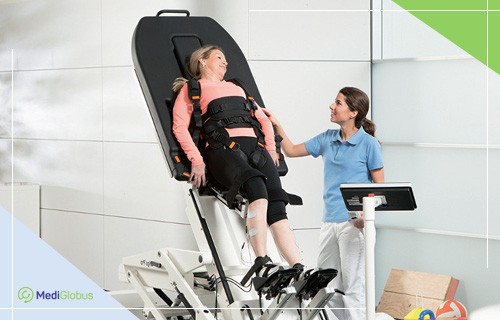
The Lokomat
The Lokomat is a special version of the treadmill for patients undergoing mobility rehabilitation. It supports the person’s weight while walking, relieving the muscles, joints and vertebrae. This allows the patient to move more freely and restore neural connections to the areas of the spinal cord responsible for walking.
Functional electrostimulation
Functional electrostimulation is a method of artificially activating sensory-motor systems using electrical current impulses. This stimulates the neural pathways responsible for muscle contraction and movement formation. The specific features of the procedure depend on which part of the spine has been damaged. The most common devices of this type include Parastep, Cimoex, ERGYS and others.
Virtual reality devices
Virtual reality devices in rehabilitation after spinal injuries are used as an auxiliary method during other exercises. They allow more realistic stimulation of vision, hearing, and tactile sensations during training. The method is particularly effective in practising movements that require balance and mobility.
MAKE AN APPOINTMENT FOR TREATMENT
Overseas clinics offer first-class treatment for spinal injuries of varying degrees of severity. Please register by filling out the form below and our coordinating physicians will consult you free of charge about treatment options abroad.
Rehabilitation after a cervical vertebral fracture
Injuries to the thoracic and cervical vertebrae are considered the most severe and have a less favourable rehabilitation prognosis. Patients experience weakness or paralysis of the arms and legs – quadriplegia. If the neck vertebrae are badly injured, the muscles that control breathing may be paralysed and the person will require a ventilator. In addition, bladder and bowel control is usually lost. Despite these factors, patients and their families should not give up. Rehabilitation after a cervical vertebral fracture is possible and depends largely on how much effort the person puts into recovery.
The methods used in rehabilitation after a cervical spinal cord injury include:
Physiotherapy;
Kinesiotherapy;
Ultrasonic therapy;
Photophoresis and iontophoresis;
Electrical stimulation;
Therapeutic massage.
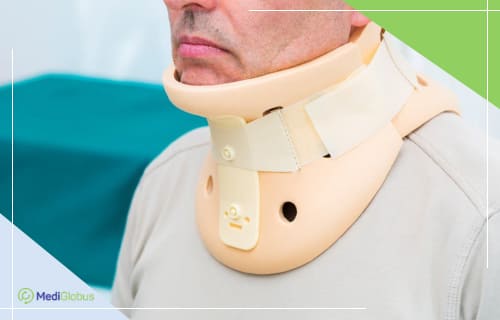
In overseas clinics, rehabilitation after a cervical spinal injury begins as soon as the patient has recovered from anaesthesia.
During recovery, the most important thing is not to stop trying to move. Physiotherapists experienced in the rehabilitation of patients with a spinal injuries will suggest safe movements to exercise the affected areas of the body. These exercises serve as a signal to the nervous system to block incoming pain.
Aggressive physiotherapy and rehabilitation after surgery also help to maximise recovery. Most of the change occurs within the first six months after injury. Any remaining loss of function seen after 12 months is likely to become permanent. Patients with a spinal cord injury need to maintain a positive attitude. The use of assistive devices – chairs, stilts, etc. – enables most people, even those with severe spinal cord injuries, to integrate into society and remain productive.
Rehabilitation after a sacral fracture
Fractures of the sacrum are most common in older people with osteoporosis and manifest as lower back pain. The prognosis is relatively good and most cases are treated conservatively with medication and moderate physiotherapy. Severe injuries to the sacrum are dangerous and are usually caused by accidents. After these, the person may need surgery and a longer rehabilitation period.
For mild injuries to the sacrum, rehabilitation begins with bed rest for about two weeks. Doctors then move on to light physiotherapy, including swimming, exercises with walkers or crutches and wearing an orthopaedic brace. Extracorporeal shockwave therapy is often used to stimulate tissue regeneration. Most patients in this group can get rid of their pain completely within 9-12 months.
In severe trauma to the sacrum, accompanied by nerve damage, surgery may often be necessary. The most common surgery that is performed in such cases is sacroplasty. During surgery, bone cement is injected into the affected vertebra under the guidance of a CT scan. The prognosis for rehabilitation in such patients is less optimistic. They often have problems with leg sensation, urination and sexual dysfunction.
Life after a spinal fracture
Spinal cord injuries are unpredictable. Some people with severe spinal compression fractures start walking suddenly. Others undergo years of physiotherapy and can only wiggle their fingers. A common theme is that patients who put a lot of effort into physiotherapy, lead a healthy lifestyle, take care of their mental health and never give up have better results.
Depending on the level and severity of the spinal cord injury, weakness or loss of motor control can significantly limit a person’s ability to perform everyday activities such as walking, dressing and going to the toilet independently. Care should also be taken if the person is left with a loss of sensation – they are vulnerable to accidental burns and may need aids or the help of a carer.
A spinal cord injury changes a life forever, but it does not take away the ability to have a full and productive life. There is a common saying among people who have undergone this trauma: “Before the injury, you could do 10,000 things. Now, it’s only 9,000. So what are you going to do: worry about the 1,000 things you can’t do, or focus on the 9,000 you still can?”
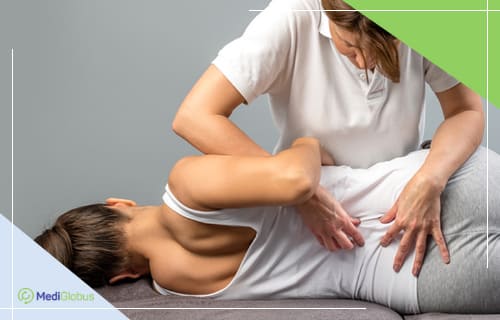
Doctors and psychologists have noticed that the greatest impact on life satisfaction after a spinal cord injury is having support from family and friends, being able to work or study, and being able to achieve independence in everyday life. In addition, over time, patients start to accept their situation and experience less depression than in the first months after the injury.
Some recommendations shared by participants in support groups for people with spinal cord injuries:
Set goals for yourself;
Learn new things;
Find activities to take your mind off negative thoughts;
Connect with other people who are in the same situation as you – in support groups or online;
Use rehabilitation aids;
Take meditation.
MediGlobus coordinating doctors will help you to find a clinic for rehabilitation after spinal injuries, depending on your budget. Leave a request online by clicking on the button below and we will call you back within half an hour.
Rehabilitation centres after a spinal fracture
When choosing a rehabilitation centre after a spinal fracture, MediGlobus advises you to pay attention to the following factors:
Availability of specialised programmes for the type of injury you are interested in;
Modern equipment;
The level of qualification of doctors;
The success rate of rehabilitation;
The complexity of the approach;
Related services;
Cost of treatment.

Among the rehabilitation clinics in Turkey, Israel, the Czech Republic, Germany, Austria and Switzerland that we can recommend:
History of a patient with a spinal cord injury
Hayden, a schoolboy from Illinois, USA, injured his spine during a football match. A bad fall damaged his C4 cervical vertebrae, paralysing him completely below the shoulders. The young man was rushed to hospital, where doctors spent the night trying to stabilise his spine. The intervention was successful, but despite the surgeons’ best efforts, the injury was very dangerous. With injuries of this intensity, there is only a 5% chance of getting back on his feet.
Hayden’s parents followed the doctor’s advice, and from the first hours began to support the young man on his road to recovery. At first, he just tried unsuccessfully to move his fingers and toes, but over time his efforts bore fruit. After a month and a half, the young man was discharged from the hospital and went to continue his treatment at the rehabilitation centre. Through intensive rehabilitation, Hayden was able to gradually progress from a power wheelchair to a manual chair, walker, crutches and finally to walking on his own.
Almost three and a half months after the stroke, Hayden was able to walk down the stairs and out of the clinic on his own.
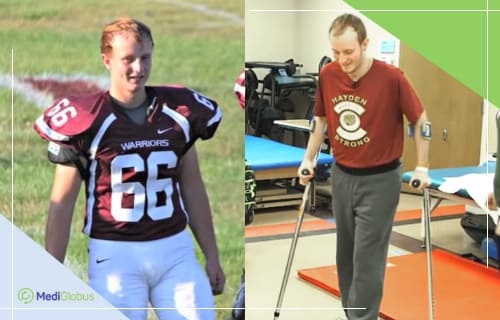
Summary
Rehabilitation after spinal injuries is a long and intensive treatment that requires the involvement of a whole team of medical professionals. The methods used in foreign clinics include physiotherapy, occupational therapy, kinesthetic, massage, ultrasound therapy, photophoresis and iontophoresis, electrical stimulation, psychotherapy, etc.
The prognosis of recovery in patients with spinal fractures depends on the location and intensity of the injury. In most spinal fracture patients, nerve function recovers within the first 6 months after injury.
Rehabilitation is more successful if treatment is started as early as possible, the patient has strong motivation and puts in a lot of effort.
The main advantages of rehabilitation abroad are access to modern treatment programmes and equipment. These allow for a greater strain on the patient’s musculoskeletal system without the risk of re-injury. This allows the nerve connections between the body and the brain to be restored.
MediGlobus specialists recommend rehabilitation centres in Turkey, Israel, the Czech Republic, Germany, Austria and Switzerland.
REHABILITATION ABROAD
Leave your application on the MediGlobus website to get help in choosing a clinic for rehabilitation after a spinal injury. We will advise you on the cost of treatment and provide free help in arranging it.




